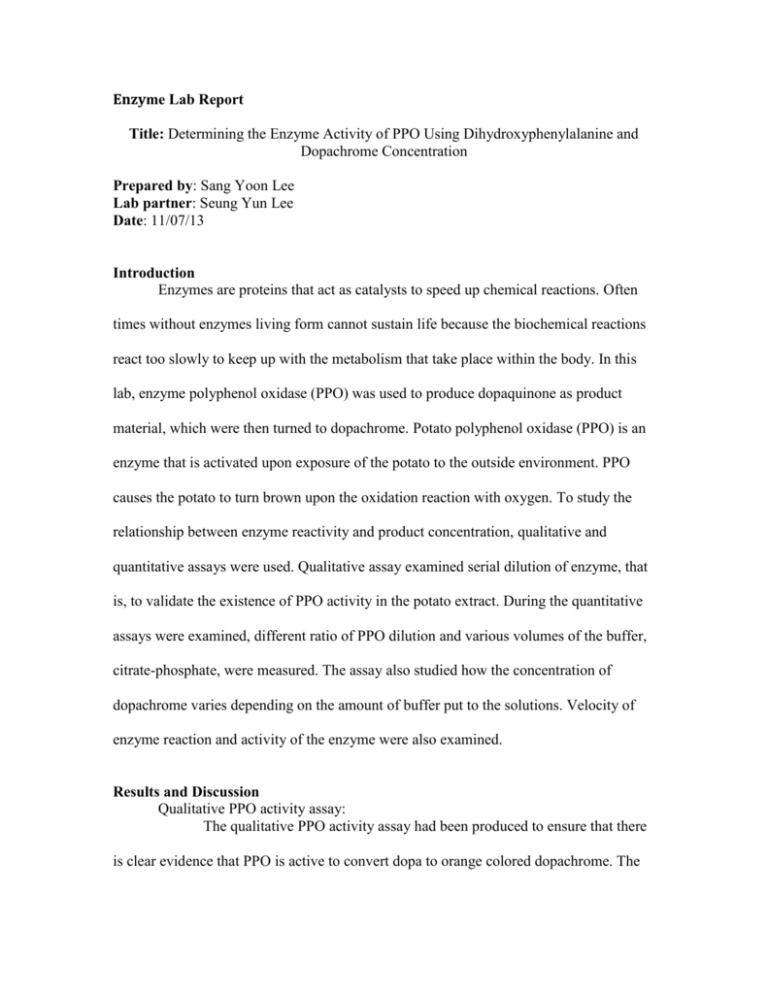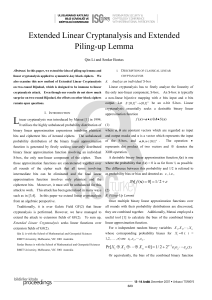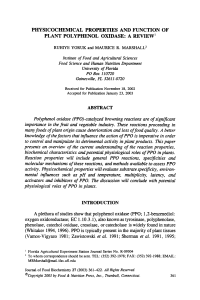Enzyme Lab Report
advertisement

Enzyme Lab Report Title: Determining the Enzyme Activity of PPO Using Dihydroxyphenylalanine and Dopachrome Concentration Prepared by: Sang Yoon Lee Lab partner: Seung Yun Lee Date: 11/07/13 Introduction Enzymes are proteins that act as catalysts to speed up chemical reactions. Often times without enzymes living form cannot sustain life because the biochemical reactions react too slowly to keep up with the metabolism that take place within the body. In this lab, enzyme polyphenol oxidase (PPO) was used to produce dopaquinone as product material, which were then turned to dopachrome. Potato polyphenol oxidase (PPO) is an enzyme that is activated upon exposure of the potato to the outside environment. PPO causes the potato to turn brown upon the oxidation reaction with oxygen. To study the relationship between enzyme reactivity and product concentration, qualitative and quantitative assays were used. Qualitative assay examined serial dilution of enzyme, that is, to validate the existence of PPO activity in the potato extract. During the quantitative assays were examined, different ratio of PPO dilution and various volumes of the buffer, citrate-phosphate, were measured. The assay also studied how the concentration of dopachrome varies depending on the amount of buffer put to the solutions. Velocity of enzyme reaction and activity of the enzyme were also examined. Results and Discussion Qualitative PPO activity assay: The qualitative PPO activity assay had been produced to ensure that there is clear evidence that PPO is active to convert dopa to orange colored dopachrome. The result had shown that 40 mM of dopa and PPO extract must be present in the same solution in order for enzymic reaction to occur. Although citrate-phosphate buffer helps enzymes to contain the active form, it did not take a crucial role on the actual reaction. Tube #2 with 0.5 ml of dopa and PPO extract present showed the positive reaction: color of the solution changed to orange due to enzyme catalysis. The other test tubes either lacked dopa or PPO extract and showed negative reaction: the color of the solution did not change. Table. Qualitative polyphenol oxidase test Tube 1 2 3 H2O 40 mM dopa Buffer 5.0 mL 5.0 mL 5.0 mL 0.5 mL 0.5 mL 0.0 mL 0.5 mL 0.0 mL 0.5 mL PPO extract 0.0 mL 0.5 mL 0.5 mL Color (+/-) + - Quantitative PPO activity assay: Different dilution ratio showed different rate of reaction. It was clearly shown that amount of dopachrome produced and absorbance rate at 475nm were linearly proportional to time and dopachrom concentration, respectively. The concentration of dopagchome and absorbance had an equation of y = 0.2147x + 0.0349, where R² = 0.99991. Also the lab had found that higher the dilution, the rate of enzymic reaction increase in linear proportion. The related graph contained the equation of y = 0.024x 0.0004, R² = 0.97671. Conclusion According to the results found higher concentration of enzyme PPO yielded higher concentration of corresponding product, dopachrome. It was phenotypically presented that test tubes with higher concentration of PPO created darker solution, evidence of higher concentration of dopachrome, after they were put into a spectrophotometer for four minutes. It should be noted that higher presence of PPO increased the rate of reaction, possibly due to a reason that more enzymes are available for substrate to bind at a given time. Unless enzymes are fully occupied with substrates and no longer can accept other substrates until the current ones are processed, the rate of dopachrome production increased linearly. It could be concluded that enzymes play the key role in expediting chemical reactions, which is critical for any organisms that require efficient metabolism.











